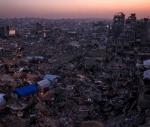You are here
When disasters and crises strike: Where to start from?
Feb 13,2022 - Last updated at Feb 13,2022
When disasters or crises occur, either man-made or natural, a quick response has to be made. The primary question that arises here is where to start from. This question is underpinned by the ways individuals and societies plan and prepare beforehand.
Before September 11, 2001, one of the major factors that reduced the effectiveness in responding to major incidents in the US was that first responders have traditionally been thought of as police, fire fighters and emergency medical personnel only who should be the first on the scene of the incident. Subsequently, this thought had resulted in passive responses from the general public. Experience however, proved if people or employees are excluded, no matter how accurate planning and preparations are, first responders will be less capable of gaining control over the scene of the incident alone.
No one should be criticised for treating an incident as serious in the first instance, even if this incident later proved it not to be. Response, as a stage, therefore starts as soon as it becomes evident that an incident is imminent and may last until other stages are declared.
Therefore, the outcome of an emergency is principally determined by the behavior of the people involved. Generally, human responses to major incidents are classified into two categories, namely spontaneous and planned. In the following sections, I will present a brief summary about each of these types. Spontaneous responses are classified as follows:
“Freezing” which often is referred to as cognitively induced paralysis. Many of the shortcomings in major incident management result from the fact that first responders are overwhelmed by the immensity of the incident and therefore are unable to develop quick understanding of the situation that would allow them to respond promptly. Responders operating in chaotic environments need immediate answers to several questions, such as what are the risks? Who should be involved? And what should we do? These questions might not have immediate answers.
Second is “avoidance”. Under high-risk scenarios, people may feel that they cannot afford making “one wrong move”. In line with this thinking, individuals seek to take highly “conservative” decisions to “avoid” potential losses. Avoidance portrays peoples’ feeling that the immediate situation should receive more attention than speculating on future scenarios, and consequently tend not to make original decisions that might further jeopardise the workplace.
Third is the “intrinsic” response. It is another type of behaviour that has the distinctive qualities of a particular person or group of people which descends from the instinctive pattern of behaviours that is culturally established by time. This type of response follows a pattern of mentally programmed actions shaped mainly by personal history which reflects past experiences.
Forth is imitation. Imitative response is a spontaneous form of behavior that follows a specific pattern copied in the minds of people as being a role model for success. Imitation in this regard is: “the process by which a low performing firm replaces a subset of its own decision choices with an equivalent set of decision choices copied from a high-performing firm”. In light of this, these organisations or societies are labelled as “followers”.
Finally is “improvisation”. People improvise for necessity, in spur of the moment, because of a lack of time for planning. Improvisation is defined as “actions taken in a spontaneous and intuitive fashion”. Outcomes of improvisation rely on the experience and skills of the responders. Improvisation is guided by intuition and characterised by both; real time and deliberate nature of the action. Improvisation entails inventing some original responses without a prearranged plan.
The second category is the planned response patters. These are divided into two broad categories:
Frist, a “standardised” behavioural response refers to establishing early parameters and controls on behaviours according to predefined guidelines. It means that each time, response will have the same steps, the same sequence and completed by the same people for all units involved. Recently, standardisation is on the rise because organisations want to restrict variability, gain consistency and reduce costs.
Second is the “dynamic” response. This pattern brings together the advantages of standardisation with the awareness of the uniqueness of individual incidents and the necessary response requirements. This allows standardisation and innovation to work together smoothly without conflict underpinned by creativity instead of rigidity of standards.
The question that remains is what sort of response we are able to demonstrate. A direct answer depends on the uniqueness of the incident, as well as our experience as individuals and societies.
Ihab Hanna Sawalha is an associate professor of Risk Management at the Risk Management Department at the American University of Madaba. He contributed this article to The Jordan Times.










